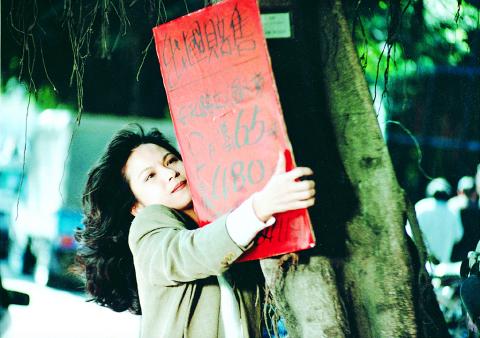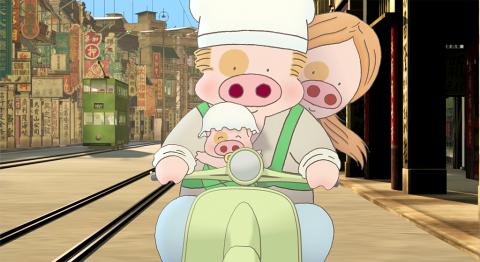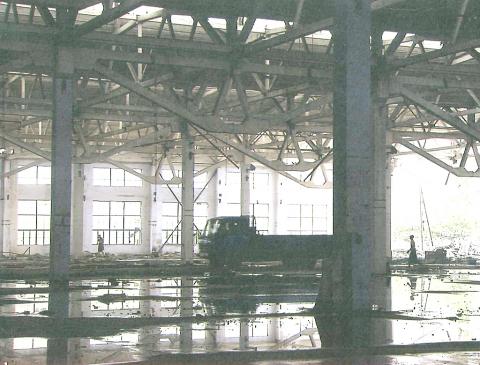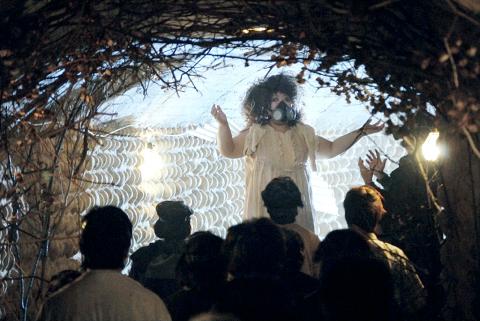Once a squatter community inhabited primarily by war veterans who retreated to Taiwan with the Chinese Nationalist Party (KMT), Treasure Hill (寶藏巖) has witnessed the city’s transformation while undergoing a metamorphosis itself to become what it is today: an artist village and youth clubhouse frequented by camera-wielding visitors.
Bearing its history in mind, there is probably no better place to hold the Treasure Hill Film Festival: Mirage — Urban and Architecture (海市蜃樓 — 城市與建築專題影展), an outdoor event that aims to explore the relation between urban inhabitants and the environment through cinema.
Co-organized by Treasure Hill Artist Village (寶藏巖國際藝術村) and Taiwan Film institute (國家電影中心), the mini-festival opens today with a lineup of 10 films from Taiwan, Hong Kong and China and runs through August 15.

Photo Courtesy of Treasure Hill Artist Village
Among the selected works, both Wan Jen’s (萬仁) 1998 Connection by Fate (超級公民) and Robinson’s Crusoe (魯賓遜漂流記, 2003) by Lin Cheng-sheng (林正盛) tackle issues surrounding land development and urban living. Meanwhile, Waterfront Villa Bonita (水岸麗景, 2007) by Lou Yi-an (樓一安) examines the absurdity of urban life through the eyes of people living on the margins of society.
Other selected films include Tsai Ming-liang’s (蔡明亮) Vive L’Amour (愛情萬歲), Chinese maestro Jia Zhangke’s (賈樟柯) 24 City (二十四城記) and McDull, Prince de la Bun (麥兜,菠蘿油王子) by Hong Kong animation director Toe Yuen (袁建滔).
The outdoor screenings will take place Fridays and Saturdays at 7pm. After each screening, there will be a panel discussion on the films and related issues featuring filmmakers, artists and scholars. All activities are free of admission, and the films have Chinese subtitles only.

Photo Courtesy of Treasure Hill Artist Village
Treasure Hill Artist Village is located at 2, Alley 14, Ln 230, Dingzhou Rd Sec 3, Taipei City (台北市汀州路三段230巷14弄2號). For more information, visit www.artistvillage.org.

Photo Courtesy of Treasure Hill Artist Village

Photo Courtesy of Treasure Hill Artist Village

Photo Courtesy of Treasure Hill Artist Village

Photo Courtesy of Treasure Hill Artist Village

This month the government ordered a one-year block of Xiaohongshu (小紅書) or Rednote, a Chinese social media platform with more than 3 million users in Taiwan. The government pointed to widespread fraud activity on the platform, along with cybersecurity failures. Officials said that they had reached out to the company and asked it to change. However, they received no response. The pro-China parties, the Chinese Nationalist Party (KMT) and Taiwan People’s Party (TPP), immediately swung into action, denouncing the ban as an attack on free speech. This “free speech” claim was then echoed by the People’s Republic of China (PRC),

Exceptions to the rule are sometimes revealing. For a brief few years, there was an emerging ideological split between the Democratic Progressive Party (DPP) and Chinese Nationalist Party (KMT) that appeared to be pushing the DPP in a direction that would be considered more liberal, and the KMT more conservative. In the previous column, “The KMT-DPP’s bureaucrat-led developmental state” (Dec. 11, page 12), we examined how Taiwan’s democratic system developed, and how both the two main parties largely accepted a similar consensus on how Taiwan should be run domestically and did not split along the left-right lines more familiar in

Many people in Taiwan first learned about universal basic income (UBI) — the idea that the government should provide regular, no-strings-attached payments to each citizen — in 2019. While seeking the Democratic nomination for the 2020 US presidential election, Andrew Yang, a politician of Taiwanese descent, said that, if elected, he’d institute a UBI of US$1,000 per month to “get the economic boot off of people’s throats, allowing them to lift their heads up, breathe, and get excited for the future.” His campaign petered out, but the concept of UBI hasn’t gone away. Throughout the industrialized world, there are fears that

Most heroes are remembered for the battles they fought. Taiwan’s Black Bat Squadron is remembered for flying into Chinese airspace 838 times between 1953 and 1967, and for the 148 men whose sacrifice bought the intelligence that kept Taiwan secure. Two-thirds of the squadron died carrying out missions most people wouldn’t learn about for another 40 years. The squadron lost 15 aircraft and 148 crew members over those 14 years, making it the deadliest unit in Taiwan’s military history by casualty rate. They flew at night, often at low altitudes, straight into some of the most heavily defended airspace in Asia.